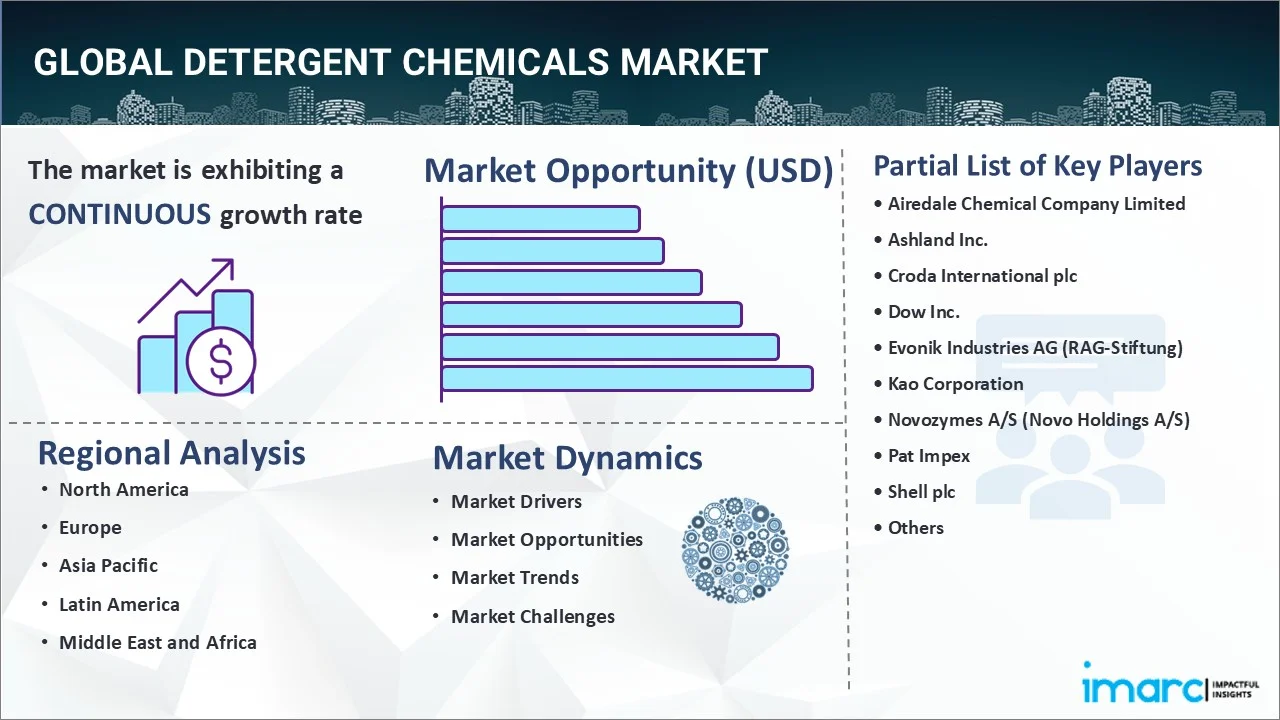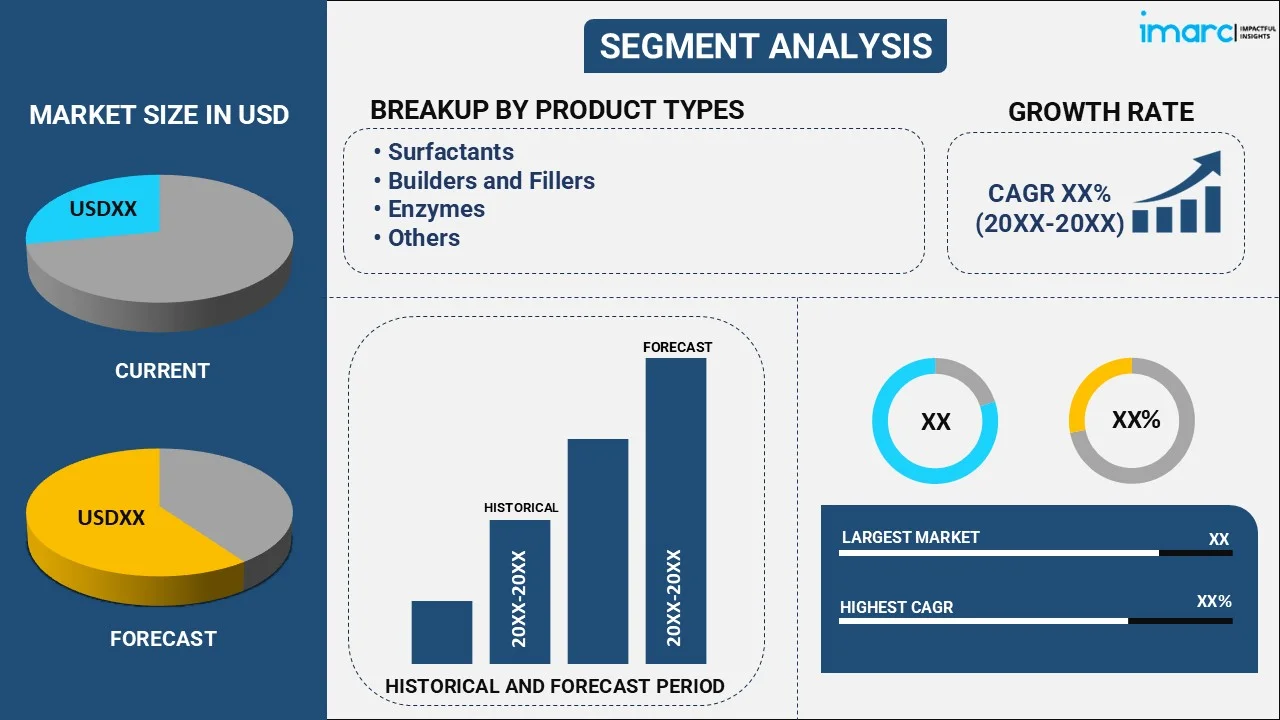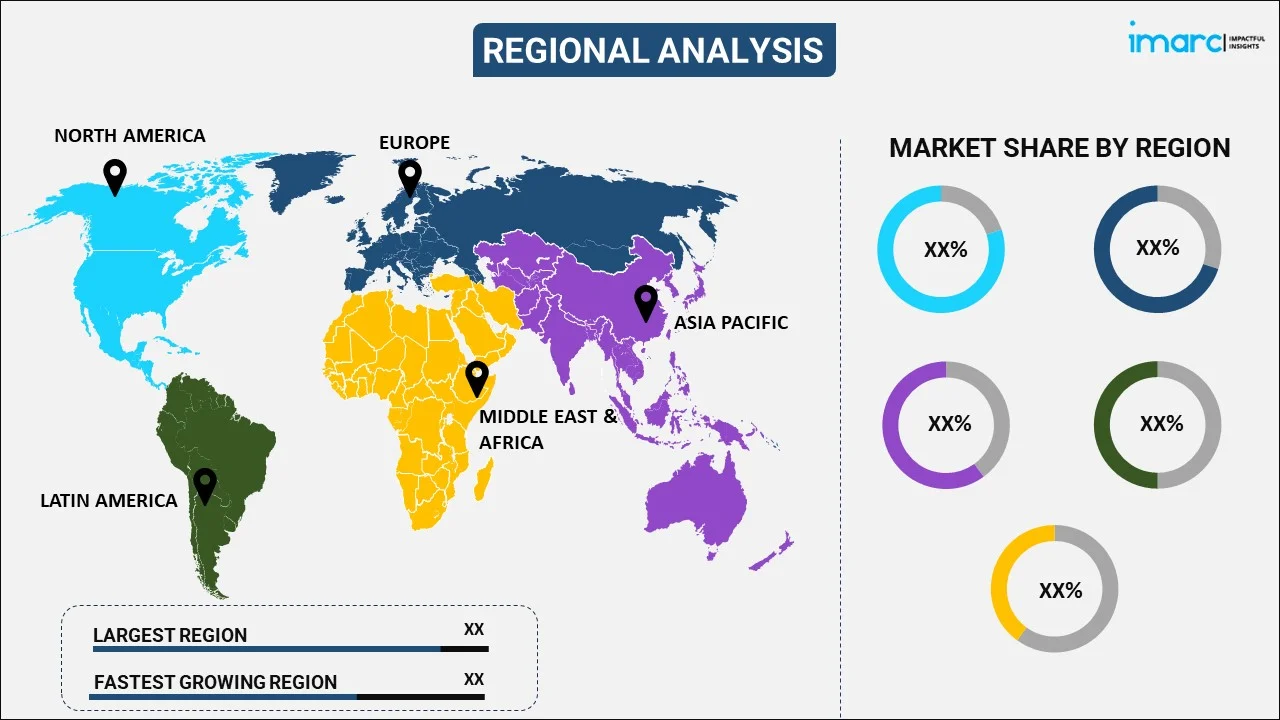
Detergent Chemicals Market Report by Product Type (Surfactants, Builders and Fillers, Enzymes, Fragrances, and Others), Form (Solid Detergents, Liquid Detergents), Application (Laundry Cleaning Products, Household and Commercial Cleaning Products, Personal Cleaning Products, Dishwashing Products, Fuel Additives, Biological Reagents, and Others), and Region 2025-2033
Market Overview:
The global detergent chemicals market size reached USD 64.5 Billion in 2024. Looking forward, IMARC Group expects the market to reach USD 115.6 Billion by 2033, exhibiting a growth rate (CAGR) of 6.7% during 2025-2033. The increasing sales of premium apparel that requires high-quality products, rising number of hospitals and clinics, and the growing consciousness about personal hygiene among individuals are some of the major factors propelling the market growth.
|
Report Attribute
|
Key Statistics
|
|---|---|
|
Base Year
|
2024 |
|
Forecast Years
|
2025-2033
|
|
Historical Years
|
2019-2024
|
| Market Size in 2024 | USD 64.5 Billion |
| Market Forecast in 2033 | USD 115.6 Billion |
| Market Growth Rate 2025-2033 | 6.7% |
Detergent chemicals are made naturally using oleochemicals derived from plant oils or synthetically produced from petrochemicals. They encompass a variety of compounds, including surfactants, builders, enzymes, bleaching agents, chelating agents, optical brighteners, fragrances, and dyes. They enhance the cleaning process by breaking down and lifting away unwanted substances, which ensures thorough and effective cleaning. They also aid in controlling odors, enhancing performance, and improving overall cleaning efficiency. They assist in improving the cleaning capabilities of detergents and lowering the surface tension of water, which allows them to penetrate and remove dirt, oil, grease, and other contaminants from clothes and different surfaces.

The increasing use of detergent chemicals in cleaning products, including laundry and dishwashing detergents, on account of their numerous advantages, is fueling the market growth around the world. Moreover, the rising demand for premium apparel that are made using high-quality materials is catalyzing the demand for detergents with fabric softeners to maintain the fabric quality, which is positively influencing the sales of detergent chemicals. In addition, the growing number of hospitals, clinics, and other healthcare facilities is catalyzing the demand for disinfectants, which are produced using detergent chemicals, to ensure stringent hygiene regulations and sanitation standards are met. Apart from this, the increasing adoption of advanced washing machines and dishwashing appliances that require specific types of detergent for optimal performance is contributing to the market growth. Furthermore, the rising consciousness about personal hygiene among individuals and inflating disposable income levels of the masses are propelling the growth of the market. Besides this, the growing adoption of detergent chemicals in the manufacturing of air room fresheners or sprays for a clean and fresh environment and rising consumer awareness about indoor air pollution are creating a positive outlook for the market.
Detergent Chemicals Market Trends/Drivers:
Increasing use of detergent chemicals in the production of fabric softeners and specialized stain removers impelling market growth
Consumers nowadays are seeking efficient and time-saving solutions that deliver superior cleaning performance. Besides this, as they are becoming more conscious about the impact of their choices on the environment, they are actively seeking detergents that minimize water pollution, reduce waste, and use renewable ingredients. These evolving preferences and lifestyle changes are contributing to an increase in the demand for innovative and environmentally friendly detergent. This, in turn, is strengthening the growth of the detergent chemicals market.
Rising industrial and institutional applications positively influencing the market
Detergents are widely used in the hospitality, healthcare, food processing, and automotive sectors across the globe. These sectors follow high standards of cleanliness and hygiene to prevent the spread of diseases. Industrial and institutional applications of detergents require specialized formulations tailored to specific cleaning challenges, including removing grease, oil, or tough stains. As new industries are emerging and existing ones are expanding, the growing need for detergents is positively influencing the growth of the market.
Growing use of detergent chemicals in manufacturing personal care products is bolstering the market growth
Detergent chemicals are widely used in the production of personal care products like hand soaps, shampoos, body washes, and other personal hygiene items. With an increase in the awareness about cleanliness and personal hygiene, there is a rise in the demand for detergent-based products that effectively remove dirt, bacteria, and other contaminants from the skin. This, along with the rising use of social media platforms and increasing celebrity endorsements is positively influencing the use personal care products. This, in turn, is strengthening the growth of the market.
Detergent Chemicals Industry Segmentation:
IMARC Group provides an analysis of the key trends in each segment of the global detergent chemicals market report, along with forecasts at the global, regional and country levels from 2025-2033. Our report has categorized the market based on product type, form, and application.
Breakup by Product type:

- Surfactants
- Builders and Fillers
- Enzymes
- Fragrances
- Others
Surfactants represents the most popular product type of detergent chemicals
The report has provided a detailed breakup and analysis of the detergent chemicals market based on the product type. This includes surfactants, builders and fillers, enzymes, fragrances, and others. According to the report, surfactants represented the largest segment. Surfactants help in reducing the surface tension of water, allowing it to spread and penetrate surfaces more effectively. They have a hydrophilic (water-loving) head and a hydrophobic (water-repelling) tail, which enables them to interact with both water and oily substances.
Builders and fillers are detergent chemicals that enhance the cleaning performance of detergents by controlling water hardness and preventing the redeposition of dirt and soil. They work by sequestering metal ions, softening the water, and improving the effectiveness of surfactants. They help control costs and ensure proper dispensing of the detergent.
Enzymes are specialized detergent chemicals derived from natural sources like bacteria or fungi. They act as biological catalysts that accelerate chemical reactions, specifically targeting and breaking down complex stains. They are effective at lower temperatures, which allows for energy-efficient cleaning. They are commonly used in laundry detergents and stain removers.
Fragrances are detergent chemicals that provide pleasant scents to cleaning products. They enhance the sensory experience of using the product by leaving a fresh and appealing aroma on fabrics, surfaces, or in the air. They can be derived from natural sources or synthesized chemically. They are added to various detergent products like laundry detergents, fabric softeners, and household cleaners, to leave a long-lasting and enjoyable scent.
Breakup by Form:
- Solid Detergents
- Liquid Detergents
Solid detergents dominate the overall market
The report has provided a detailed breakup and analysis of the detergent chemicals market based on the form. This includes solid detergents and liquid detergents. According to the report, solid detergents represented the largest segment. Solid detergents are detergent chemicals formulated in a solid or powdered form. They consist of a blend of surfactants, builders, enzymes, and other additives. They allow for easy storage, transportation, and dosing. They are often packaged in boxes, bags, or plastic containers and are measured using scoops or measuring cups. They are versatile and can be used in both high efficiency (HE) and traditional washing machines.
Liquid detergents are typically a combination of surfactants, water, builders, enzymes, fragrances, and other additives. They often come in bottles, jugs, or plastic containers with different dispensing options such as caps, pumps, or pour spouts. They are convenient to use, as they can be easily poured or dispensed directly into the washing machine or applied to surfaces. They are suitable for both handwashing and machine washing. They are widely used in laundry detergents, dishwashing detergents, household cleaners, and personal care products.
Breakup by Application:
- Laundry Cleaning Products
- Household and Commercial Cleaning Products
- Personal Cleaning Products
- Dishwashing Products
- Fuel Additives
- Biological Reagents
- Others
Detergent chemicals are widely used in laundry cleaning products
The report has provided a detailed breakup and analysis of the detergent chemicals market based on the application. This includes laundry cleaning products, household and commercial cleaning products, personal cleaning products, dishwashing products, fuel additives, biological reagents, and others. According to the report, laundry cleaning products represented the largest segment. Detergent chemicals are extensively used in laundry cleaning products, such as detergents, fabric softeners, stain removers, and laundry pre-treatment products. They help remove dirt, stains, and odors from fabrics, leaving them clean and fresh.
Detergent chemicals are employed in household and commercial cleaning products, such as all-purpose cleaners, floor cleaners, bathroom cleaners, glass cleaners, and surface disinfectants. They aid in removing dirt, grease, grime, and stains from various surfaces in homes, offices, and public spaces.
These chemicals find application in personal cleaning products, such as shampoos, body washes, soaps, hand sanitizers, and facial cleansers. They assist in the effective removal of oils, dirt, sweat, and impurities from the skin and hair.
There is an increase in the use of detergent chemicals in dishwashing detergents, dish soaps, and dishwasher detergents. They help to cut through grease, food residues, and stains on dishes, utensils, and glassware, which ensures thorough cleaning and hygiene.
Breakup by Region:

- North America
- United States
- Canada
- Europe
- Germany
- France
- United Kingdom
- Italy
- Spain
- Others
- Asia Pacific
- China
- Japan
- India
- South Korea
- Australia
- Indonesia
- Others
- Latin America
- Brazil
- Mexico
- Others
- Middle East and Africa
North America exhibits a clear dominance, accounting for the largest detergent chemicals market share
The report has also provided a comprehensive analysis of all the major regional markets, which include North America (the United States and Canada); Europe (Germany, France, the United Kingdom, Italy, Spain, and others); Asia Pacific (China, Japan, India, South Korea, Australia, Indonesia, and others); Latin America (Brazil, Mexico, and others); and the Middle East and Africa. According to the report, North America represented the largest segment.
North America held the biggest market share due to the increasing emphasis on using environment friendly and biodegradable detergent chemicals that have a lower impact on ecosystems. Besides this, governing authorities of numerous countries are implementing stringent regulations on the usage of harmful chemicals like phosphate in the manufacturing of detergents. They are also taking measures to promote the use of sustainable ingredients. Moreover, there is a rise in the adoption of advanced laundry technologies, such as high-efficiency washing machines and dryers, that require specific detergent formulations like concentrated products. Consequently, the demand for detergent chemicals that cater to these technological advancements is increasing. Besides this, the growing focus on health and hygiene practices is catalyzing the demand for cleaning products like detergents. This, in turn, is driving the demand for detergent chemicals in the region.
Asia Pacific is estimated to expand further in this domain, owing to the growing population, rapid urbanization, and increasing demand for cleaning products.
Competitive Landscape:
The top companies in the global detergent chemicals market are using nanoencapsulation technology that involves enclosing detergent chemicals within microscopic capsules or nanoparticles. It also allows for controlled release of the active ingredients during the cleaning process, which results in enhancing efficacy and targeted delivery. Moreover, key players are developing advanced formulation technologies that are utilized to optimize the performance and stability of detergent chemicals. These technologies also help improve the overall efficiency and efficacy of detergent products. Besides this, the increasing use of microbial biotechnology that involves harnessing the power of microorganisms to produce detergent chemicals is influencing the mart positively.
The report has provided a comprehensive analysis of the competitive landscape in the global detergent chemicals market. Detailed profiles of all major companies have also been provided. Some of the key players in the market include:
- Airedale Chemical Company Limited
- Ashland Inc.
- Croda International plc
- Dow Inc.
- Evonik Industries AG (RAG-Stiftung)
- Kao Corporation
- Novozymes A/S (Novo Holdings A/S)
- Pat Impex
- Shell plc
- Solvay
- Stepan Company
- Unisynth Group
Recent Developments:
- In December 2019, Evonik Industries AG (RAG-Stiftung) & Unilever Group collaborated to launch bio-based surfactants named 'Rhamnolipid.' The surfactant is mild on the skin, biodegradable, and renewable. It was used for the first time in Unilever's Quix home cleaning brand.
- Kao Corporation recently developed practicable technology for film-to-film recycling of used refill packs.
- In September 2020, Airedale Chemical Company Limited collaborated with Chemiteq and manufactured a new disinfectant product to expand their product portfolio.
Detergent Chemicals Market Report Scope:
| Report Features | Details |
|---|---|
| Base Year of the Analysis | 2024 |
| Historical Period | 2019-2024 |
| Forecast Period | 2025-2033 |
| Units | Billion USD |
| Scope of the Report | Exploration of Historical and Forecast Trends, Industry Catalysts and Challenges, Segment-Wise Historical and Predictive Market Assessment:
|
| Product Types Covered | Surfactants, Builders and Fillers, Enzymes, Fragrances, Others |
| Forms Covered | Solid Detergents, Liquid Detergents |
| Applications Covered | Laundry Cleaning Products, Household and Commercial Cleaning Products, Personal Cleaning Products, Dishwashing Products, Fuel Additives, Biological Reagents, Others |
| Regions Covered | Asia Pacific, Europe, North America, Latin America, Middle East and Africa |
| Countries Covered | United States, Canada, Germany, France, United Kingdom, Italy, Spain, China, Japan, India, South Korea, Australia, Indonesia, Brazil, Mexico |
| Companies Covered | Airedale Chemical Company Limited, Ashland Inc., Croda International plc, Dow Inc., Evonik Industries AG (RAG-Stiftung), Kao Corporation, Novozymes A/S (Novo Holdings A/S), Pat Impex, Shell plc, Solvay, Stepan Company, Unisynth Group, etc. |
| Customization Scope | 10% Free Customization |
| Post-Sale Analyst Support | 10-12 Weeks |
| Delivery Format | PDF and Excel through Email (We can also provide the editable version of the report in PPT/Word format on special request) |
Key Questions Answered in This Report:
- How has the global detergent chemicals market performed so far, and how will it perform in the coming years?
- What are the drivers, restraints, and opportunities in the global detergent chemicals market?
- What is the impact of each driver, restraint, and opportunity on the global detergent chemicals market?
- What are the key regional markets?
- Which countries represent the most attractive detergent chemicals market?
- What is the breakup of the market based on the product type?
- Which is the most attractive product type in the detergent chemicals market?
- What is the breakup of the market based on the form?
- Which is the most attractive form in the detergent chemicals market?
- What is the breakup of the market based on the application?
- Which is the most attractive application in the detergent chemicals market?
- What is the competitive structure of the global detergent chemicals market?
- Who are the key players/companies in the global detergent chemicals market?
Key Benefits for Stakeholders
- IMARC’s report offers a comprehensive quantitative analysis of various market segments, historical and current market trends, market forecasts, and dynamics of the detergent chemicals market from 2019-2033.
- The research study provides the latest information on the market drivers, challenges, and opportunities in the global detergent chemicals market.
- The study maps the leading, as well as the fastest-growing, regional markets. It further enables stakeholders to identify the key country-level markets within each region.
- Porter's five forces analysis assist stakeholders in assessing the impact of new entrants, competitive rivalry, supplier power, buyer power, and the threat of substitution. It helps stakeholders to analyze the level of competition within the detergent chemicals industry and its attractiveness.
- Competitive landscape allows stakeholders to understand their competitive environment and provides an insight into the current positions of key players in the market.
Need more help?
- Speak to our experienced analysts for insights on the current market scenarios.
- Include additional segments and countries to customize the report as per your requirement.
- Gain an unparalleled competitive advantage in your domain by understanding how to utilize the report and positively impacting your operations and revenue.
- For further assistance, please connect with our analysts.
 Inquire Before Buying
Inquire Before Buying
 Speak to an Analyst
Speak to an Analyst
 Request Brochure
Request Brochure
 Request Customization
Request Customization




.webp)




.webp)












